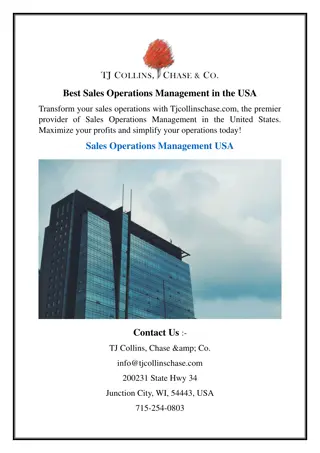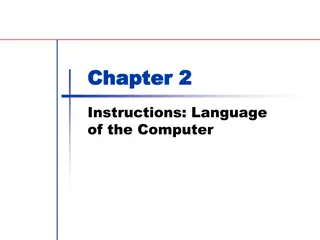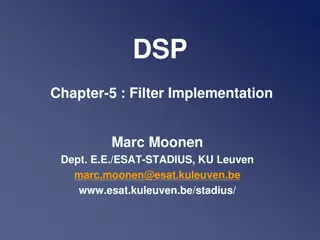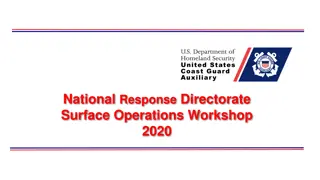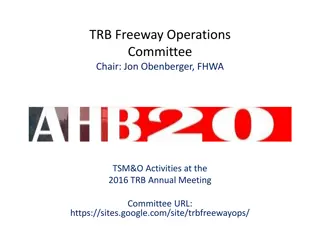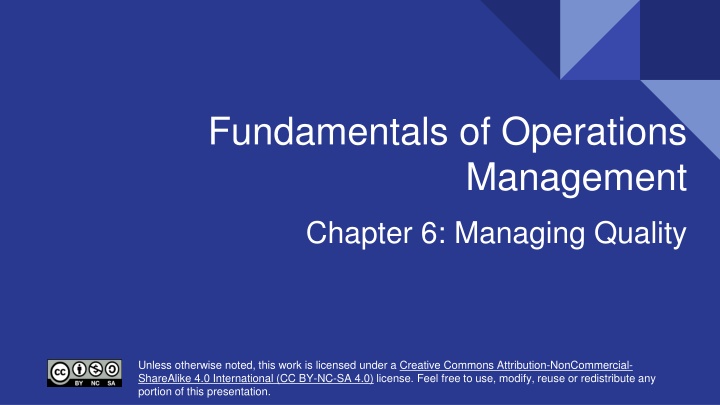
Quality Management: Evolution, Practices, and Gurus
Explore the evolution and importance of quality management in operations, including design quality vs. process quality, historical figures like Deming and Crosby, and concepts like Total Quality Management and Six Sigma. Learn about the impact of consumer perceptions on product quality and business success.
Download Presentation

Please find below an Image/Link to download the presentation.
The content on the website is provided AS IS for your information and personal use only. It may not be sold, licensed, or shared on other websites without obtaining consent from the author. If you encounter any issues during the download, it is possible that the publisher has removed the file from their server.
You are allowed to download the files provided on this website for personal or commercial use, subject to the condition that they are used lawfully. All files are the property of their respective owners.
The content on the website is provided AS IS for your information and personal use only. It may not be sold, licensed, or shared on other websites without obtaining consent from the author.
E N D
Presentation Transcript
Fundamentals of Operations Management Chapter 6: Managing Quality Creative Commons Attribution-NonCommercial-ShareAlike 4.0 International (CC BY-NC-SA 4.0) Creative Commons Attribution-NonCommercial-ShareAlike 4.0 International (CC BY-NC-SA 4.0) Unless otherwise noted, this work is licensed under a Creative Commons Attribution-NonCommercial- ShareAlike 4.0 International (CC BY-NC-SA 4.0) license. Feel free to use, modify, reuse or redistribute any portion of this presentation.
6.0 Learning Outcomes In this chapter, we will: Differentiate between design quality and process quality and explain their significant interaction in achieving overall product quality. Describe the historical evolution of quality management practices and articulate how consumer perceptions influence product quality and business success. Identify key figures in the field of quality management that contributed to the modern field of quality. Categorize and explain the various costs associated with quality management, including prevention costs, appraisal costs, internal failure costs, and external failure costs. Explain the principles and practices of Total Quality Management (TQM), ISO standards, and Six Sigma. Demonstrate the use of quality improvement tools such as control charts and Pareto charts in real-world scenarios.
6.1 Introduction to Quality Businesses worldwide aim to provide quality products and services to meet consumer expectations, as consumer perceptions of quality directly influence business success. Quality from the consumer's perspective involves understanding how consumers measure quality, which can vary based on factors like longevity, price, and performance. Historically, North American manufacturers lagged in quality until the 1980s when Japanese high-quality goods, especially in the automotive sector, highlighted the need for improvement. Quality in operations management is defined by how well a product or service meets or exceeds customer expectations, emphasizing its importance in modern business. Product quality is determined by design quality (characteristics like performance, durability, features, and aesthetics) and process quality (efficiency, consistency, and defect-free production). Measuring service quality involves evaluating elements such as tangibles, reliability, convenience, responsiveness, time, courtesy, consistency, and assurance, reflecting the more challenging nature of assessing service compared to products.
6.2 Gurus of Quality Walter A. Shewhart W. Edwards Deming Joseph M. Juran Armand Feigenbaum Philip Crosby Known as the father of statistical quality control (SQC), he developed the first control chart and emphasized reducing variation for quality improvement, distinguishing between assignable and common causes of variation. A key figure in quality management, Deming transformed Japanese manufacturing with his statistical process control techniques, Deming s 14 Points for management, and the Deming Cycle (PDCA) for continuous improvement. He introduced the Juran Trilogy (quality planning, quality control, and quality improvement), popularized the Pareto Principle (80/20 rule), and authored influential works on quality management and the cost of quality. Known for his book Quality is Free and the concept of "zero defects," Crosby argued that preventing defects from the outset is more cost-effective than inspection and rework, advocating for error elimination. Originator of Total Quality Management (TQM), Feigenbaum introduced the concept of the hidden plant, highlighting the potential for improvement by addressing inefficiencies and defects within existing operations.
6.2 Edwards Demings 14 Points: Drive out fear: Create a safe environment for effective work. Break down barriers between departments: Foster teamwork across departments. 10. Eliminate slogans and targets: Avoid adversarial relationships by addressing systemic issues. 11. Remove barriers to pride of workmanship for workers: Allow workers to take pride in their work. 12. Remove barriers to pride of workmanship for managers and engineers: Enable management and engineers to take pride in their contributions. 13. Institute a vigorous education program: Promote continuous education and self- improvement. 14. Involve everyone in the transformation: Engage the entire company in the process. 1. Create constancy of purpose toward improvement: Focus on long-term product and service improvement. Adopt the new philosophy: Embrace new approaches and leadership for change. Cease dependence on inspection: Build quality into products from the start. End business based on price: Minimize total costs with loyal, single suppliers. Improve constantly: Enhance production and services continuously. Institute training on the job: Ensure ongoing employee training. Institute leadership: Help people and equipment perform better. 8. 9. 2. 3. 4. 5. 6. 7.
6.2 The Deming Cycle Plan (P1): Do (D1): Check (C1): Act (A1): If not at target, repeat PDCA: 1.Create a new plan (P2). 2.Conduct a mini SA. 3.Keep effective actions; discard ineffective ones. 4.Add new ideas and update results continuously. If still not at target, repeat PDCA. Situation Analysis (SA): 1.Assess current condition. 2.Set an aggressive target. 3.Determine measurement methods. Action Plan: 1.Identify 3-6 actions. 2.Document steps and measurements. 3.Create a tracking document/graph. Implement the Plan that you established Check/Track the Results on a regular basis: Track progress using a document or graph.
6.2 The Pareto Principle The Pareto Principle finds numerous applications within quality management: Employee engagement: Sometimes, just 20% of employees might be responsible for generating 80% of the continuous improvement ideas. Recognizing and encouraging these valuable contributors can foster a culture of innovation within the organization. Profit distribution: In many companies, 80% of profits might be generated by just 20% of the products or services offered. Identifying and nurturing these high-performing offerings can significantly improve overall profitability. Defect concentration: It s widely accepted that 80% of defects can be traced back to a small number (20%) of root causes. Firms benefit by prioritizing the identification and rectification of these root causes.
6.3 Cost of Quality Prevention costs involve proactive measures to prevent defects, such as quality improvement programs and employee training. Appraisal costs cover expenses related to inspecting and testing products or services during production or delivery. Internal failure costs occur when defects are discovered within the organization, leading to rework, scrap, and production disruptions. External failure costs arise when defective products reach customers, resulting in replacements, recalls, legal liabilities, and damage to reputation. Figure 6.3.1: Cost of Quality by pmexamsmartnotes.com, CC BY-NC-ND 2.0
6.4 Quality Systems Quality Systems in Organizations: Many organizations use quality systems like TQM, ISO 9001, and Six Sigma to enhance their quality standards. Total Quality Management (TQM): TQM involves comprehensive steps to ensure products or services meet customer-defined specifications and maintain high quality, focusing on customer satisfaction, employee involvement, and continuous improvement. Continuous Improvement: TQM emphasizes ongoing enhancements in design, production, and delivery to increase efficiency, reduce costs, and improve customer service and satisfaction. Customer Satisfaction: TQM prioritizes fulfilling customer needs to generate profit, using customer feedback to improve products and services continuously. Employee Involvement: Effective TQM requires commitment from all employees, not just management, with proper training and teamwork (quality circles) to identify and solve quality issues. Competitive Advantage: Adhering to TQM principles helps organizations deliver high-quality products consistently, maintaining a competitive edge in the market.
6.4 ISO Standards The International Organization for Standardization (ISO) is an independent organization that develops voluntary international standards to facilitate global trade, ensure safety, reliability, and quality of products and services. Benefits of ISO Certification: ISO certification enhances quality management, operational efficiency, and risk management, while expanding market access and fostering a culture of continuous improvement. Quality Management Systems (QMS): ISO standards provide a framework for robust QMS, leading to improved product quality, customer satisfaction, and a competitive market edge. Operational Efficiency and Cost Savings: ISO standards help organizations optimize processes, reduce waste, increase productivity, and save costs by eliminating non-value- adding activities. Risk Management and Compliance: ISO standards emphasize risk-based thinking, helping organizations proactively manage risks, ensure regulatory compliance, and protect employees and assets. Certification Process: Obtaining ISO certification involves documenting and implementing quality management systems, developing a Quality Manual, and training employees, typically taking 12 to 18 months and valid for three years.
6.4 Hazard Analysis Critical Control Point Seven Principles of HACCP HACCP Overview: HACCP (Hazard Analysis Critical Control Points) is a quality management system designed for the food processing industry to manage and control food safety risks. Customer Confidence and Market Opportunities: Implementing HACCP enhances customer trust, sharpens competitive edge, and opens new export opportunities by demonstrating a commitment to food safety. Quality Control and Waste Reduction: HACCP ensures rigorous quality control measures, reduces waste and spoilage, and helps identify and manage contamination risks and recall processes. Employee Hygiene and Safety Awareness: Training on HACCP principles increases employee awareness of hygiene and safety practices, helping to eliminate potential allergen issues. HACCP Certification: Since 2005, HACCP certification has been mandatory for federally registered meat and poultry establishments in Canada and is recommended by the Canadian Food Inspection Agency for all food businesses. 1.Conduct a Hazard Analysis 2.Identify Critical Control Points (CCPs) 3.Establish Critical Limits 4.Monitor Critical Control Points 5.Establish Corrective Actions 6.Establish Record-Keeping Procedures 7.Establish Verification Procedures
6.4 Six Sigma Six Sigma is a set of techniques and tools for process improvement, aiming to minimize variation and achieve high-quality outputs with no more than 3.4 defects per million opportunities. Rooted in statistics, Six Sigma focuses on reducing defects by achieving a level of quality where 99.99966% of outputs are defect-free, significantly higher than the typical 3-sigma level. DMAIC Model: Six Sigma uses the DMAIC model for structured process improvement, driven by project teams addressing quality issues and streamlining processes. Figure 6.4.2: Cyclical diagram of the DMAIC model by Sanaz Habib CC BY-NC-SA 4.0. Figure 6.4.3: Variation of belt colours associated with Six Sigma by Zirguezi, CC0 1.0. Mods: re-coloured by Fanshawe College
6.5 Tools for Quality Improvement Scatter Diagrams Check Sheets Plot the relationship between two variables to reveal patterns, trends, or correlations. Cause and Effect Diagrams Record the frequency of occurrences of specific events or outcomes for organized data collection and analysis. Histograms Fishbone diagrams identify the root causes of problems by categorizing potential contributing factors. Control Charts Graphically display the distribution of a dataset to identify its shape, central tendency, and spread. Pareto Charts Monitor and control process quality by depicting sample variations against control limits, distinguishing between common and special causes. Bar charts showing the frequency of occurrences for different categories, helping prioritize issues based on their impact.
Summary & Review Chapter 6, Managing Quality, defines quality from the consumer s perspective, stressing that a product's success depends on meeting or exceeding customer expectations. It details the historical shift towards quality in operations management, noting the high standards set by Japanese manufacturers and the subsequent catch-up by North American companies. The chapter distinguishes between design quality (product's inherent characteristics) and process quality (consistent defect-free manufacturing processes). Key figures in quality management, known as quality gurus, are introduced, including Walter Shewhart, W. Edwards Deming, Joseph Juran, Philip Crosby, and Armand Feigenbaum, each contributing significantly to modern quality practices. Various quality systems and methodologies like Total Quality Management (TQM), ISO standards, and Six Sigma are outlined, along with the associated costs of maintaining quality. Quality improvement tools such as check sheets, histograms, Pareto charts, scatter diagrams, cause and effect diagrams, and control charts are described, emphasizing their role in monitoring, controlling, and enhancing processes for better customer satisfaction and efficiency.







